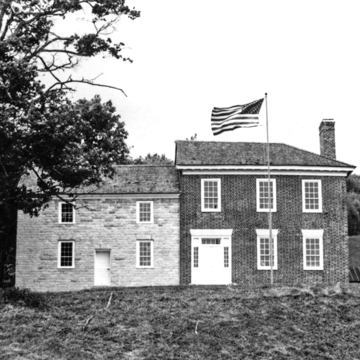Now isolated in a rural setting, the limestone section of this building was the Russell County Courthouse, one of the earliest surviving public buildings in the western part of Virginia and one of the commonwealth's few stone courthouses. Residential in appearance, it is reminiscent of the many times that courts in newly formed counties met in private houses before their courthouses could be constructed. This modest two-story courthouse, the replacement of an earlier log one, is of rusticated stone construction. After the large county of Russell was divided several times, Dickensonville was no longer in the center of the county and in 1818 lost its position as county seat, along with most of its population. The building was acquired at auction by the Dickenson family, the original owners of the land, who used it as a residence. Around 1839 they added a two-story L-shaped section with a side-passage plan, demoting the courthouse to being a front wing of a house. This brick section has Greek Revival sidelights and transom framing the entrance.
In the 1970s, the courthouse/residence began a long period of restoration that was largely completed in time for the county's 1986 bicentennial. Before that, as part of the national 1976 bicentennial, the Dickenson and Bundy log houses, both thought to date from the latter part of the eighteenth century, were moved from sites several miles away and their logs were used to construct the two-pen log house at the left of the former courthouse. The 1976 bicentennial in Virginia inspired a number of localities to move and reconstruct buildings, especially log ones, in ways that are usually more evocative than historic. They are meant to foster pride and respect for the pioneer tradition. Here the process is continuing and, so far, a half-dovetail-notched log schoolhouse, a story-and-a-half house with V-notching, and the two-story V-notched Dickenson Bundy log house (where crafts are sold) have been moved and reassembled at the old courthouse. Russell County operates the building complex as a museum.


